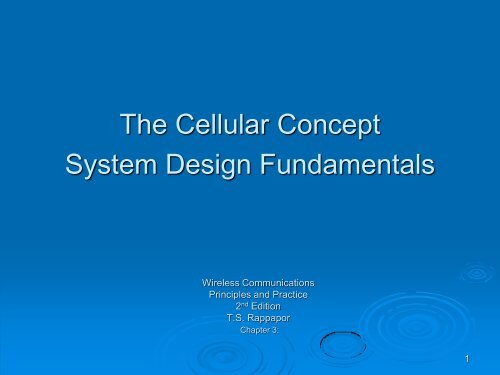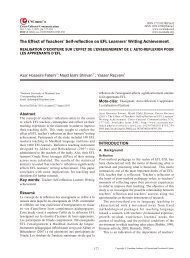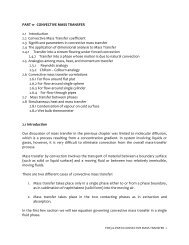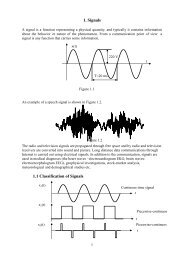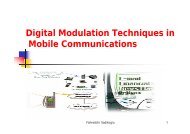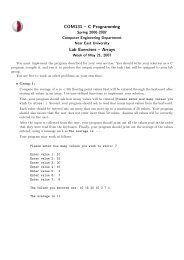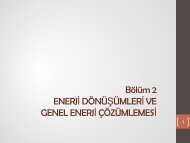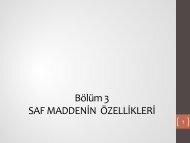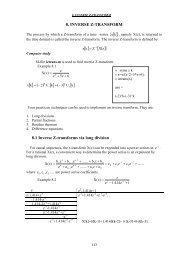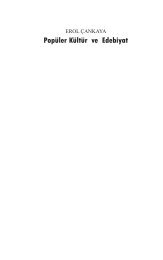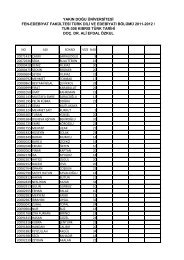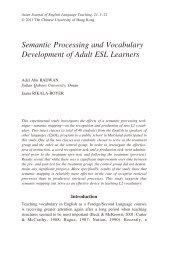Cellular concept
Cellular concept
Cellular concept
You also want an ePaper? Increase the reach of your titles
YUMPU automatically turns print PDFs into web optimized ePapers that Google loves.
The <strong>Cellular</strong> Concept<br />
System Design Fundamentals<br />
Wireless Communications<br />
Principles and Practice<br />
2 nd Edition<br />
T.S. Rappapor<br />
Chapter 3:<br />
1
Adjacent channel interference<br />
Adjacent channel interference: interference from adjacent in<br />
frequency<br />
to the desired signal.<br />
– Imperfect receiver filters allow nearby frequencies to leak into the<br />
passband<br />
– Performance degrade seriously due to near-far effect.<br />
Adjacent channel interference can be minimized through careful<br />
filtering and channel assignment.<br />
• Keep the frequency separation between each channel in a given cell as<br />
large as possible<br />
• A channel separation greater than six is needed to bring the adjacent<br />
channel interference to an acceptable level.<br />
2
The <strong>Cellular</strong> Concept<br />
3
19-cell reuse example (N=19)<br />
Figure 3.2 Method of locating co-channel cells in a cellular system. In this example, N = 19 (i.e., I = 3,<br />
j = 2). (Adapted from [Oet83] © IEEE.)<br />
4
Smaller N is greater capacity<br />
5
Handoffs – the basics<br />
6
Umbrella Cells<br />
7
Co-channel cells for 7-cell reuse<br />
8
Cochannel Interference Ratio<br />
S<br />
I<br />
S<br />
N1<br />
I k<br />
k1<br />
From Fig. 3.5<br />
S<br />
I<br />
<br />
6<br />
<br />
k1<br />
<br />
<br />
<br />
S<br />
D<br />
R<br />
k<br />
<br />
<br />
<br />
n<br />
<br />
1<br />
6(q)<br />
n<br />
<br />
q<br />
6<br />
n<br />
2 ≤ n ≥ 5 - Path loss exponent depend upon the terrain environment<br />
Worst Case With Omni Directional Antenna<br />
S<br />
I<br />
<br />
2(D R)<br />
n<br />
<br />
R<br />
2D<br />
n<br />
n<br />
<br />
2(D <br />
R)<br />
n<br />
S<br />
I<br />
<br />
2(q 1)<br />
n<br />
1<br />
2q<br />
n<br />
2(q<br />
1)<br />
n<br />
q = 4.6 for a normal 7-cell cellular Pattern<br />
S/I = 54.3 or 17.3 dB<br />
9
Cells are split to add channels<br />
Receive power at the old and new cells:<br />
Pr ~ P to R -n<br />
Pr ~ P tn( R/2) -n<br />
Pt<br />
<br />
16<br />
1<br />
Pt<br />
2<br />
10
Cell Splitting increases capacity<br />
Example<br />
Original cell radiusR = 1 km<br />
Micro cell radiusR = 0.5 km<br />
R<br />
Each BS has N bs =60 channels<br />
Number of channels<br />
3 km<br />
a) Wihout microcels<br />
5x60=300 ch.<br />
b) With lettered microcels<br />
(5+6)x60=660 ch.<br />
b) If orijinal BS replaced by<br />
microcels<br />
(5+12)x60=1020 ch.<br />
11
Sectoring improves S/I<br />
D+R<br />
D<br />
Three-Sector Case:<br />
Six-Sector Case:<br />
S<br />
I<br />
4<br />
R<br />
<br />
(D 0.7R)<br />
4<br />
(q 0.7)<br />
4<br />
S<br />
I<br />
<br />
D<br />
4<br />
4<br />
R<br />
(D 0.7R)<br />
4<br />
<br />
q<br />
4<br />
1<br />
(q 0.7)<br />
4<br />
For q=4.6 , S/I = 285 or 24.5 dB<br />
For q=4.6 , S/I = 785 or 29dB<br />
Worst case, without sectoring<br />
S<br />
I<br />
<br />
2(q 1)<br />
n<br />
1<br />
2q<br />
n<br />
2(q 1)<br />
n<br />
For q=4.6, S/I = 54.3 or 17.3 dB<br />
Penalty: İncreasing hand-off; decreasing trunking efficiency.<br />
12
Sectoring improves S/I<br />
13
In-building deployment is the<br />
next great growth phase<br />
14
The Zone Cell Concept<br />
15
Zone Cell Concept<br />
16


